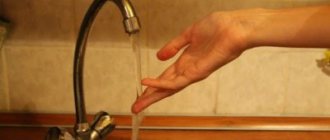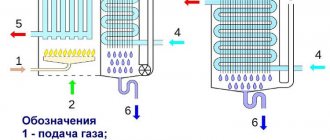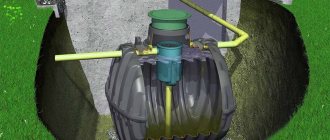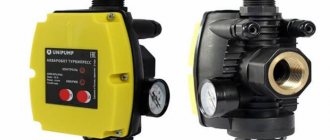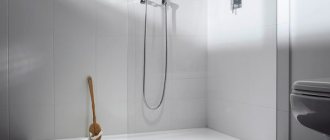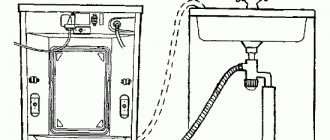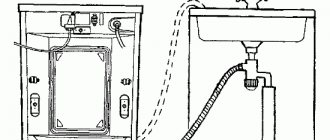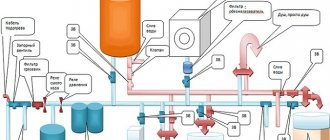18.06.2021
Draining
Editorial staff of the “New Place” website
Share
From this article you will learn
:
- Types of water drainage systems in a private house
- Sewage diagram for draining water in a private house
- Step-by-step instructions for installing a water drain in a private house with your own hands
- Secrets of preserving water drainage in a private house in winter
There can be no talk of any comfort for human living if the issue of wastewater drainage is not resolved. Draining water in a private house is a problem for many owners of small country cottages or dachas, which is very important to be able to solve and do it correctly.
In our article we will look at the principles by which sewerage should be installed, how to install it yourself, and also talk about proper preservation of the house for the winter. To do everything right, read on.
The use of septic tanks from barrels
It is advisable to build a septic tank at the dacha with your own hands from barrels in the following cases:
- as a temporary structure during the construction phase of a house before the sewer system is installed,
- with a minimum amount of waste, typical for periodic visits to a suburban area without permanent residence.
Such requirements are due to the small volume of tanks. The capacity of large barrels is usually 250 liters
Therefore, the volume of a septic tank from three tanks will be 750 liters. At the same time, according to the terms of sanitary standards, the septic tank must accommodate three daily “portions”.
It is advisable to build a septic tank from plastic barrels with your own hands as a separate treatment facility, for example, for a shower or bath
.
The advantages of such designs are:
- low cost (used containers are often used),
- simplicity of design and installation,
- less excavation work due to the small volume of tanks.
Types of devices for a country house
- Filtration septic tank with a compartment for settling the thick fraction. This is an advanced technology, the main operating principle of which is to separate sewage that enters the collector and divide it into fractions. As a result of passing through several filtration chambers, the liquid is purified to a state that is safe from the point of view of sanitary standards.
- Local treatment plant. In fact, these are mini-purification plants based on the use of bacteria to purify water.
- Using the container as a cesspool.
Country drainage can be separate and common
The first case is when wastewater from different plumbing fixtures enters different containers for sedimentation and filtration. In addition, separate delivery of water from street storm water collectors and the internal network is considered a separate form.
The general sewage collection and drainage system consists of laying a single pipeline both for indoor appliances and for collecting water outside.
Septic tank installation
Do-it-yourself sewerage from barrels requires certain preparatory work to be completed before installation. We will consider the option of making a septic tank from three barrels, but the same remains for a septic tank from two tanks.
Technological holes are made in each barrel.
In each of their barrels, in addition, holes are made at the upper end (or lids, which are often provided with tanks for ease of cleaning) for ventilation pipes.
In each tank, the inlet is located 10 cm above the outlet.
The pit for the septic tank is dug out of the barrels in such a way that when installed, there is a gap of 25 cm on each side of any tank. The bottom of the pit is covered with crushed stone or a sand cushion is arranged.
To fill the foundation, step formwork is installed
When placing barrels with a sequential decrease in level (each is 10 cm lower than the previous one), the volume of the tanks will be fully used, which is very important with the small capacity of septic tanks of this type. If the removal of purified liquid is provided through the bottom filter of the third barrel, the last tank is installed directly on crushed stone, without a foundation.
After pouring the foundation at the stage of solidification of the solution, rings or hooks are installed in it, to which clamps will cling to fix the containers
Just in case, it is better to “anchor” not only plastic, but also iron tanks.
If wastewater removal will be carried out through a filtration field, then trenches for laying corrugated pipes can be dug at this stage.
Once the foundation has gained strength, you can begin installing and securing tanks, installing pipes and sealing joints at their entry points. Experts recommend not using silicone for these purposes, preferring other types of sealants, for example, epoxy.
The trenches of the filtration field are covered with geotextile, and after laying the perforated pipes, the material is wrapped with the edges overlapping each other.
A fully assembled septic tank made from barrels is filled with soil. It is better to fill plastic containers with water at this time to avoid deformation.
During the backfilling process, the soil is periodically carefully compacted.
Simplest cleaning
If there is a lot of wastewater and you are afraid of rapid siltation of the filtration well or filtration field, it is better to supply wastewater to it after preliminary treatment . The easiest way to do this is with a sump tank - an open, wide container located between the water discharge points and the filtration system. The pipe draining water from the tank should be located 0.2–1 m above its bottom. In the sump, the water is aerated, which helps purify it, and solid waste falls to the bottom. Purified water goes further. Of course, the bottom of the sump will have to be cleaned periodically.
Do-it-yourself system installation in a private house
After the cesspool is placed on the site, you can begin to dig a trench to the required depth. In the central part of Russia it is 2-2.5 meters, in the northern regions it is a meter more, and in the southern regions it is 1-1.5 meters. They begin to dig a trench from the wastewater intake point to the top, towards the house.
Now a fine sand and gravel mixture, a “cushion,” is poured onto the bottom of the pit along its entire length. It’s better to immediately “shoot” the slope at least a little and level the sand.
The next step will be laying the pipeline itself. First, the end is inserted into the well so that the socket faces towards the house. It is advisable to immediately secure the pipe in the hole with mortar or foam. Then they are connected in series with the blank end into a socket. To simplify the process, the rubber bands are lubricated with motor oil or special lubricant.
Each pipe is measured to ensure it meets the required slope. This can be done with a building level, but it is better to take a level.
After assembling the outer line, the line is aligned along its entire length so that the entire straight section is visible through the hole.
Now the thread is sprinkled with sand and the edges are carefully tucked. Then a so-called protective layer of the same sand is poured.
Depending on the length of the outer section of the system, a fan riser is pulled to the surface every 8-10 meters. To do this, a connecting tee is inserted with the socket up, and a pipe of the same diameter is inserted into it. The fan riser needs to be mounted at the level of the soil backfill so that it sticks out slightly from the ground.
Once the route is laid, it’s time to install the system in the house. Often they dig a hole right under the foundation of the dacha and make a hole in the floor of the room where there will be a bathroom or kitchen. This is the most practical way to plant a pipe.
There is no need to insert any sleeves between the ceiling, foundation or floor. After installation, the hole must be sealed well and tightly to avoid the joints opening during operation.
If it is not possible to dig a ditch of the required depth, the drain must be insulated. Insulation of external sewerage is carried out using the following materials:
- Mineral wool.
- Fiberglass fabric.
- Expanded polystyrene shell.
- Large sawdust and roofing felt.
The method of thermal insulation for all materials is almost the same. There is no need to completely cover the line; you just need to put the insulation on top, and you can add a protective layer. However, this does not apply to the polystyrene foam shell, since it consists of two half-cylinders, which are placed entirely on the pipe and only then joined together in trenches.
Internal layout
Details about the main stages:
- First you need to decide where and what devices will be installed. Depending on their number and purpose, the diameter of the sewer pipe is selected.
- Internal highway markings. The direction of the thread is marked along the wall or floor from the lowest point to the highest. Measurements of pieces for assembly are taken.
- Before starting to assemble, brackets are installed into which the pipes will then be inserted.
- Directly assembling the pipeline by connecting them to each other with a single end into a socket. Before inserting them, the rubber bands are generously lubricated with engine oil. During assembly, it is advisable to use a 45-degree bend rather than a 90-degree bend, since the angle of rotation of the former is much softer. Straight and oblique tees are used to connect devices. It should be remembered that the sewer pipe is not static: it sometimes narrows, sometimes it expands. Therefore, a compensator must be installed in the vertical section. Also, every 5 meters at problem areas and turns it is necessary to lay cleaning inspections. These are special fittings with a screw-on lid through which blockages can be cleared.
- A prerequisite for reliable operation of the drain is to check it after installation. You can check the joints by flushing the entire system. Having assembled all the elbows and tees, insert a hose into the latter and supply water under slight pressure. If everything is done correctly, the joints will remain dry, and all the water will go to the outer part of the line (drain).
Important: the slope of the internal sewerage system is slightly greater than that of the external one. For a pipe with a diameter of 50 mm it is 3 cm per meter, and for 100 mm it is 1.5-2 cm.
Instructions on how to drain the water
1. We will need a piece of hose 2-3 meters long; the most affordable one will be a corrugated plastic hose. The hose must have no damage to the walls and no plugs from foreign objects or ice.
2. You need to tie a weight to one end of the hose with your own hands so that the hose, when immersed in the barrel, is closer to the bottom of the barrel.
3. We cut out a hole in the ice of the barrel with an axe. The end of the hose with the weight should fit into the hole.
4. Lower the hose into the hole. There's a secret here. We lower almost the entire hose under water and observe the appearance of water at the level of the hole in the hose. then with a sharp movement we pull the hose and immediately lower it below the water level - water will begin to flow through the resulting siphon. If your thumb size allows, you can plug the end of the hose and work more slowly. The main thing is not to get your hands wet at -15°C.
5. Lower the hose below the bottom of the barrel and wait for the water to drain. Then you can either close the barrel from above or tip it over. A small amount of remaining water will not harm the barrel.
6. If you need to drain several barrels, then immediately transfer the hose to the next barrel to avoid the formation of ice plugs. It was the quickly formed ice that made it difficult to fill the hose with water in the video.
This method of draining water is a full-fledged life hack and is also suitable for barrels of smaller volume, because when a metal barrel with water is tipped over, the latter can become deformed, and the plastic barrel can crack. There is also a useful effect. If your area is turbulent, then a barrel with ice along the walls and an ice plug becomes a very difficult object to move until a strong thaw sets in.
Contents
Many people solve the issue of drainage for showers in the country using “old-fashioned methods”. Some people drain water under garden plantings, others drain the drain into the sewer, and some do not care about this problem at all, believing that it is enough to install a grate under the shower frame, and then all the waste water will seep into the ground. How to drain a country shower competently and effectively?
The simplest drainage system for a summer residence.
Simple drainage sewer system for a summer residence
It is not enough to supply water to the house; after use it needs to be disposed of somewhere. It’s hard to carry it out with buckets, and it’s somehow pointless: the water comes into the house on its own, and then you have to carry it out on your own two feet. You need at least basic sewerage for your home or cottage. The option of simply removing the pipe from the house and draining the water onto the ground or a small hole will not suit everyone. It doesn't look very good, and an unpleasant smell from this puddle or hole is almost guaranteed. What to do? So, we will need: an old metal or plastic barrel, a certain amount of sewer pipes (at least 6 meters, preferably 110mm PVC), a tee, an outlet, about 0.5 cubic meters of medium-fraction crushed stone, a shovel and several hours of our precious time. We choose a place for our drainage well. Preferably, no closer than 5 meters from the house, no closer than 20-25 meters from the well or borehole and below them along the groundwater flow. We dig a hole with a diameter larger than the diameter of the barrel by at least 0.5 m (the diameter of a standard barrel is 0.6 m, height 0.9 m, volume 0.2 cubic meters) and a depth of about 1.5 m (deeper is better). We make holes in the walls of the barrel, if it is metal, then with a grinder, if it is plastic, then with a wood saw with a fine tooth. We make a hole for the incoming sewer pipe in the wall, near the bottom of the barrel. We fill the bottom of the hole with at least 20 cm of crushed stone and place the barrel upside down, oriented the hole for the pipe towards the house. Now you need to dig a trench under the sewer pipe, bringing it to the place you need. The pipe must be laid with a slope of at least 3 mm per meter towards the barrel. It can be brought into the house either under the foundation or through a hole in it. There is no need to insulate the pipe; the water flowing through it will warm it up perfectly. Not far from the barrel, we place a tee with a small piece of pipe extending above the surface of the ground to circulate air inside the barrel and allow air to exit the sewer when it is filled from the house (so that the air from the barrel does not go into your house). We insert the pipe into the barrel through the hole made for this. We fill the gap between the barrel and the wall of the pit with crushed stone to the full height of the barrel. It is advisable to put some kind of non-rotting material at the bottom of the barrel (a piece of old slate is perfect). We fill both the trench and the hole with soil, compacting it thoroughly. We make a hole in the floor or wall of the house, finally introducing the sewer into the house. Further at your discretion. On a piece of pipe sticking out of the ground not far from a buried barrel, you can put a plastic mushroom, which is difficult, but can be found in stores. And now the nuances. This is an exclusively drainage sewer system for the home; it cannot cope with fecal waste, it cannot be cleaned or maintained in any way, and it is not intended for this. This sewer can be used for drains from the kitchen or bathhouse. Drainage wells from a septic tank have the same device. The microclimate for bacteria that process wastewater depends on the depth of the pit. Ideally, the depth of the pit should be: depth of soil freezing + height of the barrel + height of the crushed stone cushion (for the Leningrad region: 1.2 m + 0.9 m + 0.2 m = 2.3 m). But digging so deep is difficult and not necessary. The effluent also warms the barrel.
Simple drainage sewer system for a dacha with drainage
If the soil at the site where the sewage system is installed is clayey, and the water leaves the barrel slowly, then the sewage system for your home can be slightly improved. To do this, you need to lay another sewer pipe, or better yet, a drainage pipe. This pipe may discharge water into a drainage ditch at the border of the site, or it may lead nowhere, ending in a dead end. The purpose of this pipe is to drain excess water from the barrel, thus increasing the area of water absorption into the soil (irrigation area). The pipe is laid in a trench on a crushed stone bed and is also covered with crushed stone and then with soil. The depth of the trench is greater than that of the supply pipe, and the slope is directed away from the barrel. Naturally, the sewer pipe will have to be damaged by a number of holes in the lower part to improve water flow, making it like a drainage pipe. This is not required if the pipe is placed in a drainage ditch.
You may be interested in similar materials::
- What to do if the sewer is frozen. To be honest, I am a little surprised that someone’s sewer can freeze. Sewage pipes, in principle, cannot freeze there.
«>
Don't make a swamp
When deciding where to put water from the shower, first of all you need to remember that it cannot be drained into open reservoirs and public storm sewer networks in villages. Well, when discharging water within the site, the main thing is not to create a swamp from your own garden.
Well
You can, for example, send such water into a ground filtration well , the walls and bottom of which allow water to pass through - from there it will slowly seep into the ground. The most common option is to dig concrete rings into the ground with holes punched with a hammer drill, and instead of the bottom, pour a layer of crushed stone 20–30 cm thick. When calculating the volume of such a structure, it is important to take into account the volume of one-time water discharge and the filtration capacity of the soil. You can conduct an experiment: dig a test well, for example, 1 m deep and 50 cm in diameter, and by pouring measured portions of water into it, calculate how long it will take for the water to go away, and then recalculate for a “large” well.
If the soil on the site does not filter water well, you can make a sealed receiving well , from which a sewage disposal truck will pump out the wastewater.
Filter field
The second option for wastewater disposal is a filtration field . The simplest example is to distribute water along a series of grooves (for example, between beds), where it will be absorbed into the soil. The filtration field can also be made underground : lay drainage pipes (with holes) in crushed stone in underground trenches. In this case, it is also important to study the drainage capacity of the soil in order to avoid flooding.
How to arrange water drainage at your dacha
In the place where the future shower is planned to be built, you need to dig a small depression and line it with plastic film or roofing felt.
Draining water at the dacha for a summer shower
It is better to concrete the recess under the shower, forming a kind of waterproof pan, so that the ground under the summer shower does not silt. Water, removing labor sweat and dust from the skin and hair, also washes away fat. These wastes, gradually settling on the soil surface, lead to siltation. Eventually, the soil will no longer allow the water used in the shower to pass through, and an unpleasant puddle will begin to appear on the floor of the shower stall.
Water flows from the pan into the gutter, so the pan should be placed on a slope. In addition, the drainage gutter must also have a slope. To drain water to a certain distance from the summer shower, you need to dig a trench under the drainage pipe. To unhinderedly drain water in a dacha, it is necessary to lay the pipe so that it has a certain slope towards the drainage pit.
Draining water in the country house for the kitchen
To drain water at the dacha, you need to connect a corrugation to the kitchen sink and create a water valve by bending the corrugation in an N shape so that water always remains in it. Then connect the corrugation to a plastic pipe with a diameter of 50 mm and bring it outside the house.
By the way, the kitchen sink should be equipped with a grate to prevent large food waste from falling into the drain pipe. An intermediate siphon must be installed on the line between the kitchen and the drainage tank. so that all foreign particles that are heavier than water settle at the bottom and do not fall into the container.
The siphon should be equipped with an inspection window so that you can unscrew the lid and drain the water with solid particles into a bucket. This will reduce the entry of organic matter and sand into the drainage container. In this case, the volume of the barrel will be enough for a longer time, the barrel will last longer, and otherwise the rotting processes will lead to its silting.
Then you need to take a metal barrel; if it is closed at both ends, then on one side you need to cut out the bottom using a chisel and hammer. Place the barrel with the open end down in the hole on a pre-filled bed of gravel and small crushed stone. The prepared pit must be larger than the height of the barrel. At the other end of the barrel, you have to make one hole for the pipe, connect the barrel and the pipe taken out of the kitchen with a tee with flanges. All joints: pipes with the barrel, as well as with the outlet pipe from the sink, must be sealed.
For better resorption of water drainage at the dacha, you can additionally dig drainage trenches on the sides of the barrel as wide as it is, approximately 1.5–2 m long. The trenches must be filled with crushed stone and large boulders. Cover the top of the trench and barrel with a layer of earth 30 to 100 cm thick, flush with the surface of the site, and cover it with turf. On top you can plant flowers, grass and a couple of birch trees - they love water. This design will last approximately 7–10 years.
Drainage well
It’s not difficult to make a shower drain mechanism yourself by using a 200-liter barrel (or an old one).
Holes are made across its entire surface. They are arranged in a checkerboard pattern, observing safety rules (wear goggles and gloves). Before burying it, part of the barrel is cut into “petals” at the base, the resulting parts are bent outward, and then installed in the ground, where the filter layer is laid. The container is wrapped in geotextile, moisture penetrates well through it. The drain pipe is inserted through a round hole made at the bottom of the barrel. This principle has been used for water drainage for a long time, and it is still used today. Tractor or car tires help make the foundation pit strong. Bricks and ceramic tiles are laid between them, and the outside is covered with drainage material (crushed stone, sand, pebbles). Filter holes are made on the sides of the tires, and the pipe is inserted into the slot of one of the tires located in the middle.
Sometimes, due to rough introduction into the natural processes of nature, it is easy to upset its fragile balance. Special requirements are put forward when fecal sewerage is built independently, because human waste is more dangerous than drainage from a water supply or shower.
How to make proper sewerage when the groundwater level is high
If, when digging a trench, water has already appeared in the upper parts, you will still have to dig to the required depth.
If the sewage system is assembled correctly, groundwater will not affect further work. To prevent water from interfering when laying pipes, the trench needs to be dug a little wider and a recess of 20–30 centimeters must be dug along its very bottom along the edge along the entire length. Liquid will accumulate in this groove, and the ditch will remain dry.
Since the cesspool, VOC, septic tank and drainage system are sealed, high groundwater levels should not affect the treatment process. However, if a VOC or septic tank is installed at the dacha, then a waste pipe or dry well is required, through which water can penetrate back into the septic tank. To avoid this, a check valve is installed on the discharge pipe.
Another solution to this problem is to place the discharge pipe from the septic tank on top into the nearest ravine, since the water comes out almost clean, and this will not harm the environment.
Connecting a pipeline is a labor-intensive process; you will need:
- fittings, tees and couplings;
- grinder to cut off some sections;
- building level;
- hammer drill and screwdriver;
- special brackets - to secure pipes.
To independently install a drainage system to a sink, bathtub or shower stall, you will need a pipe with a diameter of 50 mm; for a toilet the size will be 100 mm. If there is a bathroom on both the first and second floors, then a hundred square meters are extended upstairs, regardless of what appliances will be there.
Choosing the type of construction
Before you start laying pipes, you need to decide on the type of water supply: permanent or collapsible.
Advantages and disadvantages of permanent installation:
- the pipes are underground and do not lie underfoot;
- installation is carried out once;
- if the pipes are absent for a long time, they will not steal them (thieves are unlikely to dig in the ground);
- to prepare the system for wintering, you just need to open the drain valve and wait until all the water drains;
- material costs are slightly higher than when organizing a collapsible structure;
- the process is labor-intensive, especially if you have to dig a deep trench;
- the need to lay pipes on a slope;
- If there is a hole, it is more difficult to find and repair.
If a collapsible water supply system is chosen, the pipes can lie on the ground or be raised above it
Pros and cons of a collapsible design:
- quickly assembled and disassembled if necessary;
- if the pipes were damaged, then finding and eliminating the hole will not be difficult;
- the cost of a dismountable device is slightly lower than a permanent one;
- pipes lie underfoot;
- if you are away for a long time in the summer, pipes or hoses left unattended may simply be stolen;
- the need for assembly and disassembly at the beginning and end of the season.
Rules for choosing the volume and location of septic tanks
The daily water consumption rate is 200 liters per person, and the septic tank must be able to accommodate wastewater. Collected within 72 hours or 3 days. Thus, subject to permanent residence, a three-chamber septic tank made of 250-liter barrels is suitable only for one person. Therefore, septic tanks of this type are used only for temporary residence or for treating wastewater from one point (for example, from a bathhouse). In most cases, they try to somehow increase the capacity of septic tanks, which is why among treatment facilities made from barrels there are practically no two-chamber options (they have too small a volume).
It is important to comply with sanitary requirements regarding permissible distances from the septic tank to certain objects. For example, the distance from the source of drinking water should be at least 50 meters
Garden plants and fruit trees must be located at least 3 meters from the treatment plant. The distance to the road is at least 5 meters.
Conditions of a homemade pump for overflowing water...
To get started, I suggest you watch a video about this homemade product:
Probably many people have ever had the problem of pouring water from one vessel to another... Of course, you can simply lift and turn one vessel over another, but... this method is not always good, since the vessel can be large, that is, you will have a lot of weight containers and you simply cannot physically lift the container...
The second way is to pour, for example, in mugs... But this method is also not always good, since, for example, the shape of the vessel may not allow you to scoop up water in mugs or some other circumstances... And then the old proven method of pouring liquid comes to mind - take a flexible hose, lower one end of the hose into a container of water, and take the other end of the hose into the oral cavity and sharply blow air into yourself... Pressure will be created and then water will pour out of one container into another by inertia until you pull out the hose... Simple physics , but... this method is not very hygienic, and if the circumstances are bad, you can even choke on water... Therefore, this method is quite dangerous...
So, let's begin…
In order to make a pump we will need: - a bottle cap; - a drill and an 8 mm drill bit; - scissors or a knife; - a threaded bottle “neck”; - a flexible hose; - a small piece of pipe...
To begin, remove the gasket from under the lid and cut off its edges as shown in the photo, leaving a small “tail”...
Now we carefully place the cut gasket inside the lid and tighten it as shown in the photo... Our cut gasket will serve us as a valve...
We cut off the “neck” from another bottle and do something like a turbo water intake...
Now we put on a flexible hose from the other end of the pipe...
That's all!!! Our water overflow pump is ready...
Now we lower the side of the pipe where the valve is located into a container with water, and with sharp up and down movements we build up pressure... Water flows through the valve into the pipe and then into the hose, and from there it pours out...
Drainage well
It’s not difficult to make a shower drain mechanism yourself by using a 200-liter barrel (or an old one).
Holes are made across its entire surface. They are arranged in a checkerboard pattern, observing safety rules (wear goggles and gloves). Before burying it, part of the barrel is cut into “petals” at the base, the resulting parts are bent outward, and then installed in the ground, where the filter layer is laid. The container is wrapped in geotextile, moisture penetrates well through it. The drain pipe is inserted through a round hole made at the bottom of the barrel. This principle has been used for water drainage for a long time, and it is still used today. Tractor or car tires help make the foundation pit strong. Bricks and ceramic tiles are laid between them, and the outside is covered with drainage material (crushed stone, sand, pebbles). Filter holes are made on the sides of the tires, and the pipe is inserted into the slot of one of the tires located in the middle.
Sometimes, due to rough introduction into the natural processes of nature, it is easy to upset its fragile balance. Special requirements are put forward when fecal sewerage is built independently, because human waste is more dangerous than drainage from a water supply or shower.
Where to drain water from a summer shower in the country
Equally important when designing a summer shower is the drain for water drainage. The easiest way is to connect the drain to a special drainage ditch, if it is located on the site. A tray made of galvanized metal sheet should be installed at the base of the summer shower. The tray will prevent soil erosion under the shower.
There are several options for where to drain water from the shower at the dacha:
you can connect the drain to the central sewer, drain the water into a drainage hole, there are other ways.
Before making a drain for a shower in the country, if the pan will be located directly on the ground, you need to dig a small depression in the place where the building will be located. The pit should be filled with crushed stone, stones or completely concreted. Before concreting, this depression must be covered with roofing material so that the ground does not get wet. The pallet should be installed on, for which you can use large stones or other available materials.
Then you need to connect the pan to the drain using a pipe laid in the trench. Sometimes you can do a DIY shower drain in a country house together with a collection of soapy water located outside the shower stall. Its volume must be at least 200 liters. Not far from the summer shower, you should dig a regular hole. Its walls must be strengthened, otherwise they can collapse very quickly during operation. It is better to make the bottom and walls of the collection concrete, then water will not be absorbed into the soil and erode it.
You can arrange a septic tank for a summer shower, but it should not be located directly under the shower stall itself, since due to large volumes of water it will begin to fill with soapy water and will begin to work worse. All this can lead to the destruction of the soil, and then the foundation of the summer shower stall. To preserve the soil and the structure itself, a drain for a summer shower must be built a few meters from the shower stall, and placed next to the drainage. The drain from the summer shower should be on a slope so that it goes towards the drainage tank or trench.
It is not recommended to use clay to create a waterproof drainage layer, as over time it can erode and fill the drainage ditch. The drain must be constructed in such a way that it is ventilated. In this case, there will be no problems with unpleasant odors.
Useful video on the topic
To understand what a summer irrigation system looks like and learn more about its installation, use useful and informative videos.
Option with connection to a well:
Assembling a plastic water pipe:
Detailed overview of elements for the irrigation system:
As you can see, installing a summer water supply for irrigation is within the capabilities of any summer resident who knows how to operate a pump. If you have any questions or difficulties, we recommend contacting specialists involved in landscape design or equipping summer cottages with water supply systems.
What appears first on any suburban area? Do you think it's a fence? No, water appears first on the site. Without it, neither construction, nor living, nor maintaining the beds is possible. At the beginning of the “dacha” stage of life, the owners are engaged in arranging their home, garden and vegetable garden, but after a few years comfort comes to the fore. And when running to the well with a bucket gets boring, summer residents decide to install a summer water supply.
Norms for the distance of treatment facilities on the site
According to SNiP, treatment facilities and pits must be located at a considerable distance from the house, water well and other engineering facilities.
- From a residential building - at least 5 m to a septic tank, VOC, cesspool to avoid unpleasant odors entering the room. And also prevent in advance the possible disastrous consequences of the influence of a humid environment on the foundation of the house.
- It is 30-50 m to a water well. Of course, it is very difficult to follow this rule, since the size of the plots is very limited. It is still necessary to remove the septic tank from the water supply system as much as possible, to the extent technically possible.
- To the borders of the neighboring plot - at least 2 m.
- From the collector to plants and trees - the location is 2-4 m if the tree roots are large.
Creating a watershed
There is another way to direct storm and melt water away from the foundation of the house - by creating a watershed. In this case, costs will be minimal and efficiency will be high. The main purpose of a watershed is to direct overhead water away from a structure, collect it in ditches, and drain it away from the site.
There are two options for creating a watershed:
- The boundaries of the future watershed are determined and a canal of a certain depth is dug along its bottom so that there is a slope from the canal towards a ditch for collecting water. Next, additional channels are dug from the blind area to the channel and the soil between them is removed.
- From the blind area to the watershed boundary, bypassing work on the formation of additional channels, the soil is removed so that a slight slope from the building is obtained, ensuring the outflow of water. A kind of parapet is made from the excavated soil, sloping away from the house.
As a result of the actions performed, the building ends up on an artificial hill, thanks to which precipitation and melt water flow in the direction from the house.
To prevent softening of the soil adjacent to the structure, it is necessary to create an additional protective layer. You can make a concrete or stone platform, but this requires significant investment. An excellent solution is to use a grass lawn. It prevents water from penetrating into the lower layers of the soil, directing it in the desired direction.
Draining water from the foundation of a house is a necessity, but it is important to organize this process correctly. The result of the work will be comfortable living in the house, increasing the service life of the foundation of the house and its reliability
Materials and tools
- To dig a trench, you will need a small excavator. If there is no possibility of heavy equipment coming in, you will have to take up shovels.
- The pipes need to be cut with something, some people use a grinder with adjustable speed, or you can use a hacksaw with fine teeth.
- Jackhammer, perforator - make holes in the well and foundation of the house.
- Sand or fine ASG for fixing the pipeline in the trench.
- Insulation, thermal insulation in places where laying sewerage through an external network to a depth below the soil freezing layer is impossible.
The main segment of the drainage system is the pipe, here are its main options:
- Red PVC is available in various sizes.
- Black polyethylene ones also come in diameters from 50 to 159 mm.
- Ribbed - pragma. The length is 4 and 6 m, the diameter is from 100 mm to 500 mm.
- Gray polypropylene (plastic).
Work order:
First of all, you need to turn off the water supply. Next you should:
- Make marks on the pipe to which you want to connect the tee, in those places where you will need to cut this pipe.
- Cut off the measured part of the pipe with a metal hacksaw.
- Clean the ends of the pipes with a file.
- Place compression gaskets on the ends of the pipes.
- Install the tee.
- Connect a pipe to the tee.
- Install a shut-off valve along the pipe in any convenient place.
- Punch a hole in the wall (the pipe coming out should be at a level of a meter or more from the ground).
- Bring the pipe out at least twenty centimeters.
- Check all connections.
- Open the water supply and see if there are any leaks anywhere.
- Seal the hole in the wall with mortar.
Some tips from the professionals
In order for the sewer system in a private house to work for its intended period, you must first install it correctly. This is 80 percent of success. But even after startup, it is necessary to properly monitor the system.
- Initially, correctly organize and calculate the volume of waste.
- Pump out the cesspool in a timely manner. And not only the liquid fraction, but also the sediment at the bottom of the wells.
- Make sure that no foreign objects get into the pipe that could cause a blockage. For example, small parts of children's toys, rags, etc.
- Conduct a timely external inspection of septic tanks and pits to check their tightness.
Storm drainage for your home, what is its purpose and what is it?
The removal of “unnecessary water” is the first necessity for those areas where precipitation often occurs. After all, because of this, over the years, serious destruction of roads and paths between streets can occur, and the soil in areas becomes soggy, which then dries out for a very long time. It is also necessary to make a blind area near the house, so that rainwater will not wash away and destroy its foundation. In other words, the sewer system in its sectors will be required first of all, so that a clean and beautiful appearance is maintained for a long period, both in the yard and on the cultivated plot of land. This method of engineering work is called a rainwater drainage system.
Year-round accommodation and summer
If no one lives at the dacha in winter, then it is enough to assemble a summer sewage system. In this case, there is no need to dig a deep trench and lay a larger diameter pipeline.
The outlet from the house also does not need to be installed at the very bottom of the foundation. The exit is made directly from the top point of the plumbing fixture. A simple scheme for collecting summer sewage in the photo:
As for the collector into which the water will be drained, it must still be sealed and securely installed. There is no need to install a septic tank; a regular drainage pit will do just fine. At the end of the summer season, it will simply have to be pumped out and preserved for the winter.
If you live year-round in a private house, you will have to complicate the task a little. To use water and a toilet in cold weather, it is necessary to ensure good insulation of external sewer pipes. In addition, there are still some difficulties during installation. This includes the depth to which the external sections of the water supply system are buried, its insulation, and many other factors.
Which water supply system do you prefer: permanent or collapsible?
Before you build a summer water supply system at your dacha with your own hands, you need to decide on its location. The water pipeline can be collapsible, laid on the surface of the soil, or permanent, located underground.
Collapsible
The advantage of the summer collapsible option is that it:
- very quickly laid and easily connected to various water sources;
- all its leaks become immediately noticeable;
- Maintenance is kept to a minimum.
However, it is recommended that such a structure be disassembled and removed from the site before the onset of cold weather . If this is not done, there is a high probability of water pipes being stolen during the winter season. This forces all connections to be made collapsible. Also, pipes located next to the beds will be constantly at risk of damage.
Note: For collapsible surface water supply, rubber or silicone hoses are often used.
Constant
Such a system is being laid forever. You can use the installed water supply both in summer and winter. But, if you plan to use it in winter, you will have to bury the pipes to a sufficiently large depth, below the soil freezing level, or carry out additional insulation if their laying depth is insufficient for some reason. Since we are talking about how to make a summer water supply at the dacha with your own hands, we will consider just such a possibility of a permanent water supply.
The system is laid shallowly in areas of lawns, between trees. A depth of 25-30 cm will be sufficient. Where the pipe will pass under the beds, it should be laid much deeper to avoid damage when digging. To do this, the pipes are buried 40-45 cm or even more. Don't worry about pipes breaking in winter. In the fall, when there is no longer a need for irrigation, the water is drained from the pipes (to do this, they are laid with a slight slope or blown through with a compressor). In this condition, the pipelines are not afraid of frost.
The photo shows an example of the location of plastic water pipes in shallow trenches
Advantages of a permanent pipeline:
- a closed summer water supply system in a dacha made of polypropylene pipes does not need to be disassembled and reassembled;
- can be used in winter at appropriate laying depth;
- no one will steal the pipes.
Among the disadvantages, we can note the need to drain water from the pipes in the fall. To do this, you need to install a drain valve located at the lowest point of the system. Labor costs for excavation work will also increase. And in case of damage, a considerable amount of excavation work will have to be performed to eliminate the defect.

